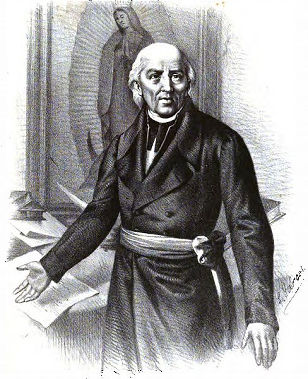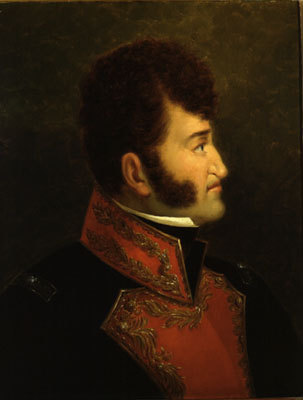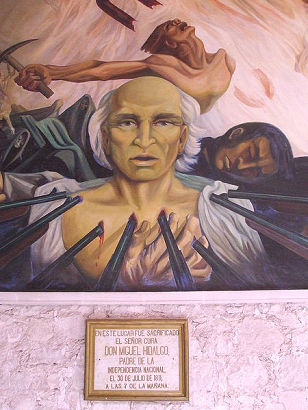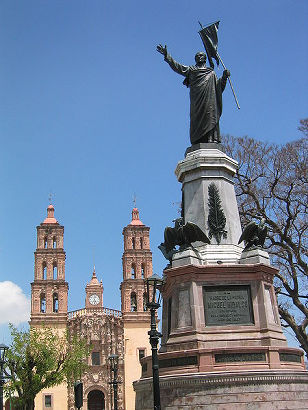|
Books by
Jeffery Robenalt
|
|
The
Revolution in Mexico was not an expression of widespread discontent
over government abuse of basic freedoms and issues of taxation without
representation, as was the American Revolution. The Mexican Revolution
was instead based on a conspiracy of the few. Among the conspirators
were the criollos, some of them military officers who were
not permitted to hold the highest ranks in the army. The criollos
wanted equality, but only with the powerful foreign born peninsulares.
Also deeply involved in the conspiracy to revolt were many merchants
and civil servants who had been exposed to the ideas of the Enlightenment
advanced by the American and French Revolutions.
However, the most radical conspirators involved in the revolutionary
movement were the parish priests who dealt with the suffering of their
Indio parishioners on a daily basis. As for the common people,
their lives were so brutally hard and lacking in basic freedoms that
their history was one of continual rebellion. Unfortunately, these
revolts were all localized and unorganized affairs that were soon
stamped out by the Spanish. |
 |
Father Miguel
Hidalgo y Costilla
Wikimedia Commons |
The
voice of the Mexican Revolution was father Miguel Hidalgo y Costilla
who was born in New Spain on May 8, 1753, of pure Spanish blood, making
him a criollo. Under the strict Spanish caste system of the
day, Hidalgo’s rights as a criollo were far less than those
of a person born in Spain known as a peninsulare, but slightly
better than those of an Indio or a person born of mixed Spanish
and Indio blood known as a mestizo.
Far from the typical priest, Father Hidalgo’s studies and belief in
the ideas expressed during the Enlightenment caused him to question
traditional political and religious views such as the absolute power
held by the Spanish King and the Pope. Unlike most priests, his behavior
included an interest in dancing, gambling, and openly living with
a mistress. The Court of Inquisition called the Father to task for
such nefarious conduct, but in the end failed to find him guilty.
After his release in 1803, Father Hidalgo assumed the duties as the
parish priest for the town of Dolores.
In New Spain, the local parish priest was one of the most influential
people in the community, and Father Hidalgo often served as the host
for social gatherings in his home where he would speak to a select
group of friends and potential conspirators about whether it was the
duty of the people to obey an unjust tyrant or overthrow him. When
Hidalgo spoke of an unjust tyrant, he was in reality referring to
Charles IV, the present king of Spain.
Not only did Father Hidalgo observe injustice and cruelty under the
rule of Charles IV in his daily work with the poor, he also strongly
opposed many of the king’s policies. For example, rather than encouraging
the growth of the colony as his father, Charles III, had done, Charles
IV exploited the colony’s wealth with schemes like his plan to use
the charitable funds of the church to help pay for his European wars.
Since these funds were a vital source of credit for the Criollos,
many of them, including Hidalgo’s father, were financially ruined
when the church was forced to call in their mortgages. Uprisings in
Spain against Charles IV eventually forced him to abdicate the throne
in favor of his son. |
 |
Ignacio Allende
portrait by JoseInes Tovilla
Wikimedia Commons |
|
A few years
later, during a meeting of a literary circle in the city of Queretaro,
Father Hidalgo met a Captain of Calvary, Ignacio Allende.
Capitan Allende introduced him to the prominent members of his revolutionary
coterie. The committee was deeply involved in a conspiracy for the
independence of New Spain, and the conspirators felt they needed
a member with moral authority, a relationship with the lower classes,
and good family connections. Father Hidalgo fit this role perfectly.
He was actively recruited and joined without reservation.
Napoleon had recently conquered Spain and put his brother Joseph
on the Spanish throne in place of Ferdinand VII. Hidalgo’s conspiracy
planned to separate New Spain from Napoleonic Spain and then place
Ferdinand VII on the throne of New Spain. The committee chose December
10, as the day to begin the revolution. Unfortunately, word of the
conspiracy was leaked to the Spanish authorities before the conspirators
were ready to act. Hidalgo was in Dolores on September 15, with
the other members of the conspiracy when they learned of the betrayal.
Terrified of Spanish reprisals, most members of the conspiracy were
ready to flee for their lives, but Father Hidalgo understood the
need to take positive action. On the following morning, September
16, 1810, he proceeded to the church in Dolores and rang the bells
calling in every parishioner within range of their urgent appeal.
Reaching out to the crowd from the pulpit in what has come to be
known as the “Grito de Dolores”, (the Cry of Dolores)
Hidalgo announced his intention to declare independence from Spain
and exhorted the crowd to join him in his holy crusade. The people,
shouting “death to the Gauchupines”, (Gauchupines was also
a name given to the Peninsulares) flocked to his banner,
and he soon had an army of 600 men. In response to Hidalgo’s call
of “Viva Guadalupe”, the Virgin of Guadalupe became
the symbol of Mexican independence.
Joined by Ignacio Allende as their military commander, and with
Father Hidalgo at their head, the army of the people marched for
San Miguel, gathering strength as it marched. The revolutionaries,
surprising the authorities with their intensity, took San Miguel
with no trouble and the local militia joined them. Unfortunately,
the rebels soon fell to looting and pillaging the town, taking out
their fury on the hated Peninsulares and even executing prisoners.
This abhorrent conduct caused friction between Hidalgo and Allende,
when Allende attempted to break up the needless violence. Hidalgo
rebuked him, accusing him of mistreating the people.
Hidalgo’s revolutionary army next captured Celya and then
marched to Guanajuato, arriving on September 28. There, instead
of surrendering, the Peninsulares and Criollos who
opposed the revolution barricaded themselves in the town’s heavily
fortified public granary and decided to wait for help from Mexico
City. The expected help never came, and in the savage fighting that
followed more than 500 Peninsulares and Criollos were
killed when the rebel army, by now numbering more than 30,000 souls,
overran the fortifications and slaughtered them. The town was then
looted and the entire population suffered no matter what their class.
After the destruction of Guanajuato, Hidalgo’s army continued its
march to Mexico City, arriving there in late October with
more than 80,000 men. The Viceroy chose to take the offensive rather
than waiting behind the city’s walls for an attack. Hastily organizing
a force of only 1,000 infantry, 400 horseman, and two cannons, all
that could be found on such short notice, he sent them out to meet
the rebels.
The two armies clashed on the slopes of the Monte de Las Cruces
(Mount of the Crosses) on October 30, 1810, but with the Royalists
so heavily outnumbered the result was predictable. When their cannons
were captured during the savage fighting, the soldiers led by the
Peninsulares retreated to the safety of the city. Although
an immediate attack by the rebels would have undoubtedly captured
the capital, Hidalgo, against the stringent advice of Allende, ordered
a retreat.
The mysterious retreat has puzzled historians ever since. Some have
reasoned Hidalgo feared that the 4,000 man royalist army of General
Felix Calleja was closing in, but it could never have arrived in
time to save the capital. Others have speculated that Hidalgo wanted
to save the citizens of Mexico City from the looting and pillage
that would have surely followed a rebel victory, but this type of
concern had never stayed the priest’s hand in the past. For whatever
reason the decision was made, it proved to be a grievous tactical
error as it gave the Spanish forces under General Calleja
an opportunity to regroup.
Hidalgo and Allende had a temporary falling out as a result of Father
Hidalgo’s decision to retreat, and although the revolutionary leaders
soon came together again at Guadalajara, the situation between them
remained tense. Meanwhile, the Royalists under Calleja caught up
with the rebel army on January 17, 1811, at Puente de Calderon
(Calderon Bridge) near the entrance to Guadalajara. Once again the
soldiers of the Peninsulares were heavily outnumbered, but
this time good fortune smiled on them when a stray cannonball happened
to plow into a rebel munitions wagon. The tremendous explosion,
smoke, fire, and chaos that followed caused Hidalgo’s undisciplined
and untrained revolutionary soldiers to break and run.
Father Hidalgo and Ignacio Allende were forced to flee north, but
once in Texas they were betrayed by
local insurrection leader Ignacio Elizondo and turned over
to the Spanish authorities. The Spanish sent them to Chihuahua
to stand trial where they were found guilty and sentenced to death.
Allende was executed by firing squad on June 26, 1811, shot in the
back as a sign of dishonor, but Father Hidalgo, as a priest, had
to undergo a civil trial and answer to the inquisition as well.
He was eventually stripped of his priesthood and executed on July
30. The heads of both Hidalgo and Allende were preserved and hung
on the walls of the granary at Guanajuato as a warning to those
foolish enough to follow in their footsteps.
|
 |
Mural depicting
Hidalgo execution in Chihuahua
Creative
Commons |
The
Mexican revolution in Texas took a similar
course on January 21, 1811, when a retired militia captain from the
province of Nuevo Santander, Juan Bautista de las Casas, and
a group of Spanish army sergeants staged a coup in San
Antonio. The following morning the members of the coup arrested
the Spanish governor of Texas, Manuel
Maria de Salcedo, and named Bautista governor of the state of Texas,
independent from Spain. The revolutionaries quickly took control of
Nacogdoches and
La
Bahia, but the arbitrary rule and unauthorized confiscation of
property by Governor Bautista soon turned many of the people and much
of the army against him.
The loyalist soldiers, led by Juan Manuel Zambrano marched
on the government house in San
Antonio, and Juan Bautista surrendered without a fight on March
2, just 39 days after assuming power. The revolutionaries, including
Bautista, were quickly judged and convicted by royalists in Coahuila,
and executed by firing squad. Juan Bautista de las Casas’s body was
buried in Monclova, but his head was shipped to San
Antonio where it was stuck atop a pole and put on display in the
military plaza. |
 |
Statue of Father
Miguel Hidalgo in front of Dolores Church
Wikimedia Commons |
Even
though the revolution led by Father Hidalgo had failed, it opened
the peoples’ eyes to the possibility of freedom, and the priest’s
martyrdom allowed others to pick up the fallen banner of independence.
The struggle continued for several more years until a group of liberals
in Spain forced the king to make changes that frightened the conservatives
in Mexico City. The conservatives finally joined forces with the followers
of Father Hidalgo to defeat the Spanish, and on August 24, 1821, a
treaty was signed granting Mexico independence from Spain. Texas
became a province of the new Republic of Mexico.
Father Miguel Hidalgo y Costilla is today remembered as the Father
of his Country and the great hero of Mexico’s long struggle for independence.
His remains lie in a Mexico City monument known as “the Angel of
Independence” along with other revolutionary heroes.
© Jeffery
Robenalt, August
1, 2011 Column
More "A Glimpse of Texas Past"
jeffrobenalt@yahoo.com |
|
|
